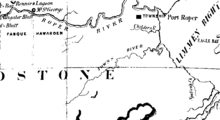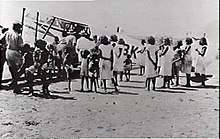Ngukurr
Ngukurr, formerly Roper River Mission (1908−1968), is a remote Aboriginal community on the banks of the Roper River in southern Arnhem Land, Northern Territory.
| Ngukurr Northern Territory | |
|---|---|
 Ngukurr | |
| Coordinates | 13°44′00″S 134°44′00″E |
| Population | 1,056 (2011 census)[1] |
| Postcode(s) | 0852 |
| Location | 636 km (395 mi) SE of Darwin |
| LGA(s) | Roper Gulf Region |
| Territory electorate(s) | Arnhem |
| Federal Division(s) | Lingiari |
A number of different clans and language groups are represented in the town, with Kriol being the main language spoken. Collectively, the Aboriginal people in the Roper River area refer to themselves as Yugul Mangi, and the township is run by the Yugul Mangi Development Aboriginal Corporation (YMD), which represents about 200 people in seven clans.
Founded as the Roper River Mission in 1908, the settlement was taken over by the Northern Territory Government's Welfare Department in 1968, and handed over to the community in 1988, at which time it was renamed Ngukurr.
History
.jpg)



The town was originally settled by the Church Missionary Society in 1908, known then as the Roper River Mission.[3] As well as bringing "Christianity and civilisation" to the local Aboriginal people, it was intended to provide a dwelling place for them, to be safe from mass killings by white settlers.[4] The Eastern and African Cold Storage Company had driven the people off their lands, planning to set up cattle stations and export the meat around the world. The missionaries protected them from death by starvation or massacre, but banned their languages and traditional ceremonies.[5]
Children had to live in dormitories, while their parents and relatives lived elsewhere. A separate compound for leprosy sufferers was created in 1928. The mission moved to the present site in 1940, after a major flood destroyed the mission station.[4]
After the Bombing of Darwin during World War II in 1942, the mission children were relocated to New South Wales, and then South Australia and Alice Springs.[4]
The Welfare Branch of the Northern Territory Government took over management of the town in 1968.[4][6]
In 1988, control of the community was handed to the Yugul Mangi Community Government Council, and the township was renamed Ngukurr.[4] In 2008, Yugul Mangi Development Aboriginal Corporation (YMD) was established.[7]
Language
The main language spoken by Ngukurr residents is Kriol.[8] There are number of traditional Australian Aboriginal Languages that people of Ngukurr have as part of their heritage, including Alawa, Marra, Warndarrang, Ngandi, Ngalakgan, Nunggubuyu, Ritharrngu and Wägilak. These languages are all endangered languages. The Ngukurr Language Centre carries out various programs to support the revitalisation of the community's traditional languages.[9] Kriol programs are supported by a local program called Meigim Kriol Strongbala.[10] English is the primary language used in government services such as health, education and local government.
Administration
Yugul Mangi Development Aboriginal Corporation (YMD) was established in 2008 after changes to the Local Government Act, which created the Roper Gulf Shire (now Roper Gulf Regional Council). YMD works closely with the Regional Council to provide services and economic opportunities in Ngukurr and surrounding areas. It represents about 300 people of the seven clans of South East Arnhem land.[7]
Crossing Roper Bar
In 2004, pianist and composer Paul Grabowsky visited Ngukurr in order to meet the traditional songmen. He met with the elders and heard two Wagilak songmen sing, and asked permission to bring his orchestra on a return visit. When he returned in 2005, he brought singer-songwriters Archie Roach and his wife Ruby Hunter, along with 10 members of his Australian Art Orchestra. After working together for five days, the musicians staged a concert in the town. The European musicians learnt about the manikay (song cycles) and were led to experiment with whole new ways of exploring sound.[5]
The resulting project, called Crossing Roper Bar, toured the Northern Territory, played at the Birrarung Marr park in Melbourne, the National Gallery of Victoria, Apollo Bay Music Festival and the Sydney Opera House. When the group travelled to Gulkula to play at the 2006 Garma Festival, the Yolgnu songmen from nearby regions were amazed, thinking that those songs had been lost long ago. In 2010 a Crossing Roper Bar album was released.[5]
Notable people
Phillip Roberts was a resident of the Roper River Mission (now Ngukurr) and his biography became an award-winning book, I, the Aboriginal, by Douglas Lockwood.[11]
Actor and musician, Tom E. Lewis, grew up in the Roper River Mission before moving into acting with his role in the film The Chant of Jimmie Blacksmith. His mother, Angelina George, also grew up in the Roper River Mission and, along with her sisters, became a renowned painter.[12]
Dexter Daniels made significant contributions to the 1960s movement to award Aboriginal stockman equal pay, a movement that was further highlighted by the famous Wave Hill walk-off.[13]
The Reverend Canon Michael Gumbuli Wurramara (AM) became the Northern Territory's first Indigenous Anglican priest in 1973 when he became rector of St Matthew's Anglican Church in Ngukurr.[14]
Cherry Wulumirr Daniels received a medal of the Order of Australia in 2016 for service to her community.[15] Her career included working as a teacher and educator, leading a local women's Indigenous ranger group[16] and teaching her traditional language of Ngandi.[17]
Artist and custodian of traditional law for the Wagilak people, Djambu "Sambo" Barra Barra (born c.1946) and his wife Amy Jirwulurr Johnson, also a noted artist, live at Ngukurr.[18][19][5]
References
- Australian Bureau of Statistics (31 October 2012). "Ngukurr (Urban Centre/Locality)". 2011 Census QuickStats. Retrieved 17 January 2015.

- John Sands, The New atlas of Australia Sydney : J. Sands, [1886]
- "Ngukurr". NT Place Names Register. Retrieved 17 January 2015.
- "Roper River Mission - Place". National Centre for Indigenous Genomics. The Australian National University. 14 May 2015. Retrieved 20 February 2020.
- Power, Lisa (30 July 2010). "Crossing the divide". The Sydney Morning Herald. Retrieved 20 February 2020.
- "Profile". Northern Territory Government. Dept of Community Welfare. Archived from the original on 23 January 2015. Retrieved 23 January 2015.
- "About". Yugul Mangi Development Aboriginal Corporation. Retrieved 20 February 2020.
- "2016 Census QuickStats - Ngukurr".
- "Ngukurr Language Centre (About)".
- "Meigim Kriol Strongbala (Make Kriol Strong)".
- "Biography - Philip Roberts - Indigenous Australia". ia.anu.edu.au.
- "CooeeArt Since 1981". www.aiam100.com.
- Australia, National Museum of. "Collaborating for Indigenous Rights Home". indigenousrights.net.au.
- "Natural, fair-minded leader of people". Sydney Morning Herald (June 14, 2010). Retrieved 31 January 2015.
- "Nine Indigenous figures in Queen's Birthday Honours List".
- Salleh, Anna (7 July 2016). "Way of the water lilies: Where science meets the billabong".
- "Future of endangered Indigenous language rests with youth". 16 April 2017.
- "Profile of Sambo Burra Burra". Explore Aboriginal Art, its history, culture and development. Retrieved 20 February 2020.
- "Djambu Barra Barra Paintings". Japingka Aboriginal Art Gallery. 19 July 2014. Retrieved 20 February 2020.
Further reading
- "Roper River Mission". Find & Connect. 27 August 1908.